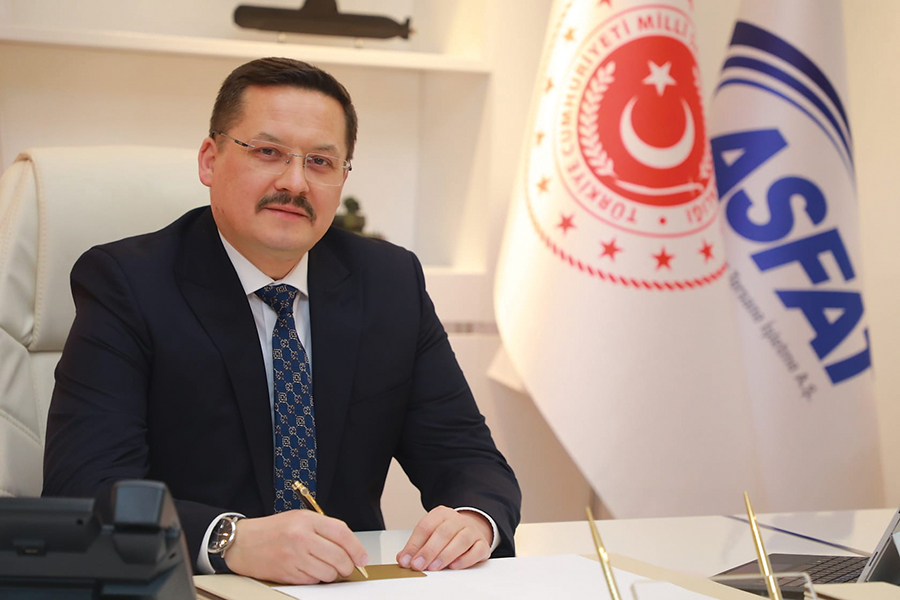Co-operation is Key for ASFAT
Although only half a decade old, Turkish’s defence contractor, ASFAT has been making positive inroads in the Asia-Pacific region. With specified, tailored plans for the maritime forces here, as the company’s Chief Executive Officer, Esad Akgün tells ADJ Today, ASFAT will be working closely with governments here in the Asia-Pacific region to provide whole package to support the forces’ operational readiness.
ADJ Today: Could you share with our readers on ASFAT’s latest innovations to equip the world’s naval forces?
Akgün: Established on Jan 12, 2018, under the Turkish Ministry of National Defence, ASFAT has set out with the mission of bringing the capabilities of Military Factory and Shipyards in the fields of production, maintenance, and repair as well as modernisation and sustainability to the national economy through export, supporting the transfer of Turkish Defence Industry capabilities to foreign markets, and contributing to the modernisation of factories and shipyards with the income generated. ASFAT, drawing on more than 30 years of experience of 27 military factories and 3 shipyards, is authorised to use these national facilities’ large workforce capacity.
Active in both the operations area and defence industry, ASFAT is a result-oriented project management company that can generate a solution in all areas according to demand.
PN MILGEM is one of the prominent naval projects of ASFAT. Produced as a masterpiece of Turkish engineers, upon the MILGEM project, which has successfully waved the Turkish flag in the world’s oceans, with the agreement signed on Sept 6, 2018 between Pakistan and Türkiye, PN MİLGEM corvettes will become a part of the Pakistan Navy inventory. This agreement is the highest figure ever signed by the Turkish defence industry at a time.
PN MILGEM programme consists of four ships; two ships will be built in Istanbul Shipyard Command, and two ships will be built at Karachi Shipyard & Engineering Works’ (KS&EW’s) facility. The programme started on March 11, 2019. The deliveries of the ships, which will be able to perform all kinds of military duties from air defence to submarine defence, are expected to be made at six-month intervals starting from August 2023.
Another critical naval platform project initiated by ASFAT is the off-shore patrol vessel (OPV). The OPV project was designed and produced with a very high local rate to meet the two OPV needs of the Naval Forces Command of Turkiye. The ship will have a high local production rate and perform multi-role missions on the open seas to replace some frigate missions that were held on Aug 15, 2021.
ASFAT is also successfully carrying out the design process of the TF-2000 Air Defence Warfare (ADW) Destroyer. The TF-2000 destroyers will be capable of detecting low/medium/high-altitude short/medium/long-range guided missiles and ballistic missiles, as well as destroying non-ballistic missiles.
I would like to mention about the Jinnah-class frigate (JCF) design project as well. The JCF project is a frigate design project developed jointly by the ASFAT Design Office and Pakistan Navy’s Platform Design Wing (PDW) to meet the operational requirements of the Pakistan Navy and has equally shared intellectual propriety rights.
The project also includes a technology transfer programme initiated by Turkiye for the first time to another country for transferring the design know-how of a primary combatant warship. In this regard, it is among the few examples in the world. The first vessel of JCF is planned to be built at KS&EW.
In addition to this, ASFAT also coordinates the process of the national submarine development programme, national submarine (MILDEN), that began in 2012. The Turkish Naval Forces and the defence industry are now taking steps to construct the MILDEN based on knowledge and know-how gained by their competent engineers and workers in the prideful materialisation of the national ship, the MILGEM-class corvettes and frigates.
ADJ Today: Most of the Asian naval forces are fast modernising their surface fleet. Could you tell us when is the best time frame for them to consider upgrades or procurement of a new vessel altogether? What is the pro and contra for both decisions?
Akgün:The best time frame for modernising or procuring a new ship depends on several factors, including the age and condition of existing vessels, emerging threats in the area, available budget and resources, and the Navy’s strategic goals. It is generally accepted that ships have a lifespan period of 30-40 years.
In order to remain as the deterrent forces in the changing security environment, the navies may choose to carry out alternative modernisation plans instead of direct ship procurement. This approach is seen as a more suitable method compared to the high costs of procuring new ships. Modernisation programmes require many processes, such as installing new combat systems, electronic warfare systems, sensors, combat management systems, and weapon systems equipment to improve the ship’s capabilities and extend its life. In general, modernisation programmes are implemented for naval vessels every five-year period. These programmes are carried out as overhaul (maintenance) activities. Naval ships often undergo a comprehensive mid-life modernisation programme at their 15th year of lifespan. The cost of a half-life modernisation is generally 1/8 of the main cost of the ship.
On the other hand, the supply of new ships is seen as essential if the existing fleet is ageing and no longer meets the operational requirements of the Navy. Although this process depends on many factors, it generally comes to the fore after the existing ships have completed 30-40 years of their lifespan. A new ship with state-of-the-art technology and capabilities will be a force element that will provide significant support to the operational readiness of the Navy.
Both approaches have pros and cons and every Navy has its own unique needs depending on existing conditions, environmental conditions and threat perception. Upgrading existing ships could be a more cost-effective way to extend life-time of fleets yet, may not be sufficient to provide emerging security threats in the region. The purchase of a new vessel could provide a significant increase in the capabilities of the Navy, but this method can be more costly and take a long time to eventually. In order to get effective results from a procurement programme, the planning period should be put into effect five years in advance. After the 15-20 years’ service life of naval ships is completed, their modernisation cost increases. The navies may put new procurement programmes on their agenda after this period, directly proportional to their economic power and the ships in their inventory.
To sum up, naval forces choose to modernise their fleet, procure new ships, or both depending on their unique circumstances. As ASFAT, we follow the developments in the countries on this subject to date. ASFAT has capabilities in both modernisation and shipbuilding. For example, we are one of the four main business partners in the Turkish Navy’s Prezeve class submarine mid-life modernisation programme. That is why, we are working to provide result-oriented, customised solutions primarily for the countries in the Asia-Pacific region.
ADJ Today: There were plans from ASFAT to provide a wholesome package for the surface fleet of Asia-Pacific naval forces. Could you elaborate on this programme?
Akgün: ASFAT participated in the offshore patrol vessel project tender initiated by the Philippines Navy in the Asia-Pacific region. We have signed an MOU with the Philippine Aerospace Defence Company in April 2022 for the OPVs planned to be built for the Philippine Navy. The Philippines was planning to supply six ships under this programme. Our offer included six OPV’s which were planning to be explicitly designed for the Philippines and two ULAQ-armed unmanned sea vehicles.
ADJ Today: What are your aspirations for this year’s LIMA’23? What are the products and solutions will you be showcasing here?
Akgün: ASFAT’s participation in this exhibition aims to enhance defence industry cooperation between Turkiye and Malaysia and ensure regional security. ASFAT’s capabilities cover all of the platforms required for the Royal Malaysian Navy’s transition programme from 15 different maritime platforms to 5 main platforms (#15to5). Negotiations are ongoing within this framework. Furthermore, considering the modernisation activities of the Land Forces Command, the products, and solutions we exhibit will include those that can meet Malaysia’s defence needs. In addition, the negotiations we will hold at the exhibition will allow for the development of collaborations that will contribute to Malaysia’s defence industry. These services can be carried out efficiently and cost-effectively under ASFAT and in partnership with Malaysia’s local capabilities. ASFAT’s participation in this exhibition is essential in developing regional defence industry co-operation and partnerships.
At LIMA ’23, we will exhibit our products from the naval, land, and air platforms. From the land platforms, we will display MEMATT (Mechanical Mine Clearing Vehicle) and ARPAN 155 (8×8 howitzer). For the naval platforms – PN MILGEM Corvette, OPV, 10,000-ton floating dock, 3,000-ton submarine floating dock, and ASBOT KN35 Security Patrol Boat. We will exhibit our A400M retrofit capability, HGK-82 and 84 precision guidance kit, and firefighting kit products from the air platforms. The Turkish Armed Forces are the leading user of these platforms. All of the products have proven themselves in the field. MEMATT has been delivered to several countries including Azerbaijan, Togo, and Burkina Faso. Additionally, we will exhibit our maintenance, repair, and modernisation capabilities and solutions in a video display format.
ADJ Today: Could you tell us on your future plans for ASFAT here in the Asia-Pacific region?
Akgün: As ASFAT, we have been endeavouring to work in close co-operation and co-ordination with the Asia-Pacific region since the establishment of the company. We regularly participate in defence exhibitions organised by countries in the region and share our products and capabilities with friendly and allied countries through exhibitions as well as other opportunities. The Asia-Pacific region will continue to be a crucial area for ASFAT and other essential defence companies in the world.
As a well-known company in Asia-Pacific region, ASFAT has excellent relations with the countries in the area and closely follows the future procurement plans of sister countries such as Malaysia, the Philippines, Bangladesh, and Indonesia and continues to work to offer tailor-made solutions for these needs. We are not here to sell, we are here to establish bonds and relations bilaterally. Business is just a tool for sustainment and self-sufficiency. Preparation for security is time and finance consuming; therefore we offer sustainability to our brother Malaysia. Malaysia is not just an allied country for us, it’s a brother country and Nation.
ADJ Today: Is there anything else you would like to add, Sir?
Akgün: ASFAT, in addition to the products and solutions exhibited, has the authority to use the capabilities and opportunities derived from the experience of more than 30 years in the manufacture, maintenance, repair, and modernisation areas of 27 military Factories and three Naval Shipyards. As a wholly government owned entity, ASFAT has the full authority to sign government to government (G2G) agreements on behalf of the Republic of Türkiye. ASFAT operates under the Ministry of National Defence, and its Chairman of the Board is the Deputy Minister of National Defence. Therefore, all projects have government guarantees.
ASFAT, which celebrates its fifth year this year, has business development activities in more than 30 countries. The project size has reached $3 billion, and 55% is export-based.
ASFAT’s participation in the defence industry exhibition held in Malaysia is essential in enhancing Malaysia’s defence capabilities and developing regional defence cooperation. MILGEM-class ships intellectual property (IP) rights belong to Ministry of National Defence Turkiye. Additionally, the intellectual property rights of all platforms, such as MEMATT and ASBOT, which we will exhibit at LIMA’23, belong to us.
In conclusion, ASFAT’s participation in LIMA’23 will enhance cooperation and partnerships in the defence industry and pave the way for developing new collaborations. We also wish for the exhibition to be a successful platform for all participants to exhibit their products and solutions and to foster mutual understanding and goodwill among the global defence community.


